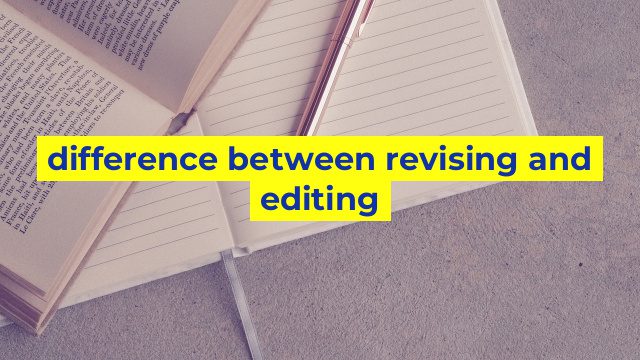The Difference Between Revising and Editing
When writing content, it is easy to get caught up in the process of just getting the words out. However, the most important step to producing polished, high-quality content is in the revision and editing process. Many people use the terms “revising” and “editing” interchangeably, but they actually refer to different steps in the writing process. Here’s what you need to know.
What is Revision?
Revision focuses on the big-picture elements of your writing. This means analyzing the structure, flow, and organization of your text. During the revision phase, you’ll be asking yourself questions like:
- Does my writing flow logically and coherently?
- Are my ideas presented in a clear and concise manner?
- Does the overall structure of my piece make sense?
When revising, you may need to reorganize paragraphs, delete entire sections, or add new information to bolster your argument. Basically, revision is where you make sure that all of the important elements of your content are in place and working together effectively.
What is Editing?
Editing, on the other hand, focuses more on the details of your writing. This is where you’ll be checking for things like grammar and punctuation errors, word choice, and sentence structure. During the editing phase, you’ll be looking for:
- Spelling, grammar, and punctuation errors
- Ambiguity or vagueness in your language
- Overuse of cliches or repetitive phrasing
- Sentences that are too long or difficult to understand
It’s important to be meticulous while editing, as even small errors can detract from the overall quality of your content.
Why Both Steps Are Necessary
It’s important to understand that both revising and editing are necessary steps in the writing process. Revising ensures that your content is well-organized and your message is clear, while editing helps to polish your writing to a professional standard.
Ultimately, both steps work together to create content that is effective and impactful.
As a writer, it can be tempting to rush through the revision and editing process in order to finish your writing project quickly. However, taking the time to properly revise and edit your work can make a huge difference in how your content is received by your audience. By focusing on both steps and giving each one the attention it deserves, you’ll be able to create writing that is both engaging and error-free.
Table difference between revising and editing
| Revising | Editing | |
|---|---|---|
| Definition | Refining the content, organization, and style of a text. | Correcting errors in grammar, punctuation, spelling, and formatting. |
| Focus | The big picture – improving the overall clarity and effectiveness of the message. | The details – ensuring that the text is error-free and conforms to style and formatting guidelines. |
| Process | May involve adding, removing, or rearranging content; considering the audience and purpose; and improving sentence and paragraph structure. | Involves correcting and fine-tuning the text by carefully reviewing each sentence and word. |
| Timing | Typically done after an initial draft is complete, and before editing. | Typically done after revisions are complete, and before proofreading. |
| Goal | To improve the overall quality and effectiveness of the text. | To ensure that the text is error-free and conforms to style and formatting guidelines. |

